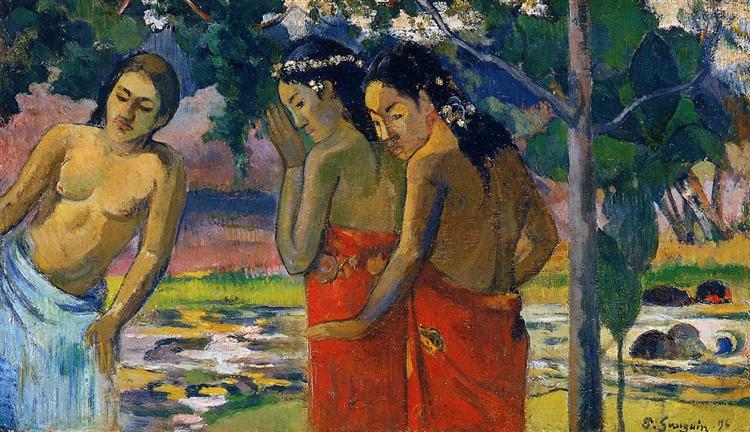説明
Paul Gauguin's "Three Tahitian Women" (1896) represents a notable milestone in the fusion of Western culture with the visual and spiritual richness of the Polynesian world. In this painting, Gauguin manages to capture the essence of his fascination with Tahiti, a place that symbolizes for him both personal exile and the search for a “purity” that contrasts with the Western civilization he had left behind.
The composition of the work is characterised by the triangular arrangement of the three female figures, who become the central focus of the painting. The women are dressed in grass skirts and present a range of expressions and postures that infuse the work with life and character. Their faces, although simplified, convey an introspection that suggests a deep connection with their environment and culture. The singer on the left, almost in a static profile, looks on contemplatively while the other two women, closer to the viewer, seem to be in dialogue with each other, engaged in an everyday moment of Tahitian life.
In terms of colour, Gauguin uses a vibrant palette, with yellow, green and blue enveloping the figures in an almost dreamlike atmosphere. The warm tones seem to emanate from the figures, contrasting with the unnatural blue background that evokes the tropical atmosphere of Tahiti, but which could also be interpreted as a symbolic, almost metaphysical space. The choice of bright colours alludes both to the exuberance of the Tahitian landscape and to Gauguin's search to create a visual language that transcends reality.
Interestingly, symbolic meanings of the elements present in the painting have been mentioned. The fruits and flowers that adorn the background could represent fertility and the culture of Tahitian life. Furthermore, the use of symbolism in his earlier works opens up the possibility of readings that go beyond the literal, suggesting a critique of the values of Western society. Gauguin seeks an art that transcends realistic representation, advocating a sense of the primitive and the instinctive that resonates with the viewer on a visceral level.
The work not only captures the women in their cultural context, but also reflects Gauguin’s obsession with exoticism and the primacy of depiction of island life, which he had idealised during his time in Tahiti. His search for the “primitive” here becomes a commentary on modernity and an exploration of identity in relation to space, colour and form.
A central figure in the Post-Impressionist movement, Paul Gauguin continues to influence generations of artists. His unique style, incorporating elements of Symbolism and Fauvism, redefined the art of his time. “Three Tahitian Women” represents a crossroads between tradition and innovation, reminding us of the complexity of human experience projected through the beauty of painting. In this sense, the work establishes itself not only as a portrait of Tahitian life, but as a profound meditation on the role of art in the search for truth amidst culture and nature.
KUADROS ©, a famous painting on your wall.
Hand-made oil painting reproductions, with the quality of professional artists and the distinctive seal of KUADROS ©.
Painting reproduction service with satisfaction guarantee. If you are not completely satisfied with the replica of your painting, we will refund 100% of your money.

